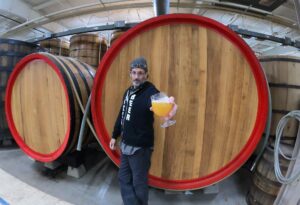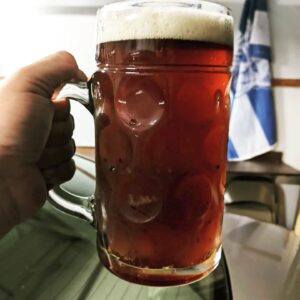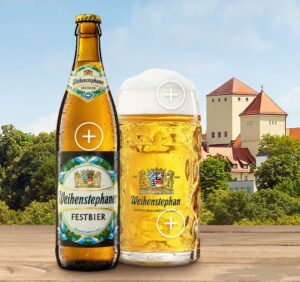
Ron Jeffries was that rarest of contemporary craft brewers, a genuine inspired innovator and mentor to a great many who followed in his footsteps. Jeffries, who died this week, founded the Michigan-based Jolly Pumpkin Artisan Ales in 2004.
Using traditional Belgian brewing methods of open fermentation, oak-aging, & bottle conditioning allow the influence of wild yeast & bacteria to work their way into our beers.
Interestingly, when Jeffries and his wife first named their company, it occurred to neither of them that beer fans would assume they were using pumpkins to make beer. Ten years passed before Jolly Pumpkin La Parcela emerged, deploying real pumpkin, cacao and the brewery’s characteristic oak aging.
At the first fall beer festival, people started asking for pumpkin beer, and we were like, ‘Well, we don’t have any pumpkin beer.’ Then it became a bit of a joke with people who knew the brewery and people who didn’t because at subsequent festivals, people in line would ask for the pumpkin beer and people behind them would be, like, ‘They don’t make a pumpkin beer!’”
Of course sour/wild beers eventually became all the rage, and to an extent they still are, as too often infused, confused and submerged with flavorings in ways that can be mighty infuriating to we purists, but Jeffries approached them in staunchly traditionalist fashion and conjured an amazing product line. For that alone, he deserves every last plaudit.
—
I never met Jeffries but read about him and watched a few videos, and not once can I recall hearing him suggest that his ales should be consumed “ice cold.”
Forty-two years into this journey of beer and brewing betterment, and I’m still fascinated by the American obsession with “ice cold” beer. Whenever I see these two words attached to local brewery offerings, I do pirouettes in my grave — and I’m not even dead (yet).
If beer actually tastes good, does it really need to be served “ice cold”?
And, if beer actually tastes good, doesn’t serving it “ice cold” numb the taste buds and render the potential sensory enjoyment absolutely meaningless?
I suppose “ice cold beer” is a reflex action traced to traumatic ancestral memories of Blatz or Wiedemann, similar to saying “Gesundheit” when someone sneezes, although it’s likely that few readers under the age of 50 know what this means.
Gesundheit was borrowed from German, where it literally means “health”; it was formed by a combination of gesund (“healthy”) and -heit (“-hood”). Wishing a person good health when they sneezed was traditionally believed to forestall the illness that a sneeze often portends.
All of which reminds me that Halloween is right around the corner. No sooner have thousands of area residents retired their kitschy Oktoberfest costumes than they’ll be merrily cosplaying through the neighborhood as Darth Trump or a human-sized Kale Pineapple Smoothie.
—
Play-acting aside, as it pertains to seasonal German lagers, here’s a brief buying guide to styles.
Märzen (the original fuller-bodied version) and (Oktober)(Fest)bier, the ubiquitous toned-down modern variant, suit both season and occasion.
Märzen typically is more complex in design and colored in tawnier shades of amber, brown and orange (heavier in the mouth), while Festbier looks little different from an attractive golden Dortmunder (read: more quaffable).
Both are crisp, clean and offer malty flavor profiles with the discreet, yet firm presence of classic Bavarian “noble” hops. Märzen and Festbier are an epicure’s sheer delight, pairing as well with loaded pizza or enchiladas as the fowl, beef and pork devoured at Bavarian harvest galas.
American craft-brewed versions of Oktoberfest can be Märzen or Festbier depending on an individual brewer’s whim. Some are rigorously true to style, others not so much, although usually American-brewed Oktoberfests fall somewhere within the identifiable spectrum, and it’s been a good while since I experienced a head-scratcher.
My own mental cheat sheet reminds me to revel in the differing guises of American Oktoberfest, and enjoy them just the way they are. Your bullet points:
- Old School Märzen: Märzen is the traditional style. It’s fuller and maltier, hops minimal, with an amber to brown color.
- New School Festbier: Festbier (or Wiesn, after the “meadow” in Munich where the fest is held) is a rich golden color, milder than Märzen, fuller than Helles, crisp, clean and very drinkable.
- Wide Ranging American Oktoberfest: American Oktoberfest most often is a fun style hybrid, sometimes leaning Märzen, other times Festbier.
Now go forth and forage, and remember that pumpkin spices do not belong in this discussion.
—
Local news: Over at Louisville Business First, Michael L. Jones reveals that Gravely Brewing Co. (514 Baxter Ave.) has new food.

Gravely Brewing Co. adds Eliana’s Honduran Café to its food program
Honduran cuisine is a mixture of Native American, Spanish, Caribbean and African flavors. Eliana’s Honduran Café features classics like pastelitos, and tostadas along with shareables like yuca fries and quesadillas.
Speaking of food and the way that pints of cool cellar temperature (not ice cold) cask-conditioned ale can be paired with vastly caloric edibles, the British pub chain Wetherspoon (has) slashed breakfast pricing.
What I have got is a perfectly good plate of hot food. It’s pleasing to find a Lincolnshire sausage that’s herby and meaty and not like some of the horrific cheap bangers served up by greasy spoons. The egg has a nice runny yolk, the rasher of back bacon is decent and the beans and hash brown are as you’d expect.

A gently hoppy, session-strength Ordinary Bitter with my cooked morning repast, please — and I’ll have a nice long nap around noon.
—
Previously at “Hip Hops”:
Hip Hops: A memoir — or, the beer that ignores history has no past, and no future






















 Roger Baylor is an entrepreneur, educator, and innovator with
Roger Baylor is an entrepreneur, educator, and innovator with 



